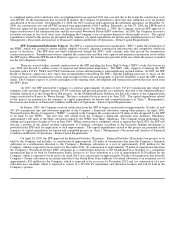OG&E 2009 Annual Report Download - page 21
Download and view the complete annual report
Please find page 21 of the 2009 OG&E annual report below. You can navigate through the pages in the report by either clicking on the pages listed below, or by using the keyword search tool below to find specific information within the annual report.
In recent years, the regulatory environments in which we operate have received an increased amount of public attention. It is
possible that there could be changes in the regulatory environment that would impair our ability to fully recover costs historically
absorbed by our customers. State utility commissions generally possess broad powers to ensure that the needs of the utility customers
are being met. We cannot assure that the OCC, APSC and the FERC will grant us rate increases in the future or in the amounts we
request, and they could instead lower our rates.
We are unable to predict the impact on our operating results from the future regulatory activities of any of the agencies that
regulate us. Changes in regulations or the imposition of additional regulations could have an adverse impact on our results of
operations.
Our rates are subject to rate regulation by the states of Oklahoma and Arkansas, as well as by a Federal agency, whose regulatory
paradigms and goals may not be consistent.
We are currently a vertically integrated electric utility and most of our revenue results from the sale of electricity to retail
customers subject to bundled rates that are approved by the applicable state utility commission and from the sale of electricity to
wholesale customers subject to rates and other matters approved by the FERC.
We operate in Oklahoma and western Arkansas and are subject to rate regulation by the OCC and the APSC, in addition to
the FERC. Exposure to inconsistent state and Federal regulatory standards may limit our ability to operate profitably. Further
alteration of the regulatory landscape in which we operate may harm our financial position and results of operations.
Costs of compliance with environmental laws and regulations are significant and the cost of compliance with future environmental
laws and regulations may adversely affect our results of operations, financial position, or liquidity.
We are subject to extensive Federal, state and local environmental statutes, rules and regulations relating to air quality, water
quality, waste management, wildlife mortality, natural resources and health and safety that could, among other things, restrict or limit
the output of certain facilities or the use of certain fuels required for the production of electricity and/or require additional pollution
control equipment and otherwise increase costs. There are significant capital, operating and other costs associated with compliance
with these environmental statutes, rules and regulations and those costs may be even more significant in the future. For example, the
EPA has proposed lowering the ambient standards for ozone and SO2. If these standards are adopted, reductions in emissions from our
electric generating facilities could be required, which may result in significant capital and operating expenditures.
There is inherent risk of the incurrence of environmental costs and liabilities in our operations due to our handling of natural
gas, air emissions related to our operations and historical industry operations and waste disposal practices. For example, an accidental
release from one of our facilities could subject us to substantial liabilities arising from environmental cleanup and restoration costs,
claims made by neighboring landowners and other third parties for personal injury and property damage and fines or penalties for
related violations of environmental laws or regulations. We may be unable to recover these costs from insurance. Moreover, the
possibility exists that stricter laws, regulations or enforcement policies could significantly increase compliance costs and the cost of
any remediation that may become necessary.
There also is growing concern nationally and internationally about global climate change and the contribution of emissions of
greenhouse gases including, most significantly, carbon dioxide. This concern has led to increased interest in legislation at the Federal
level, actions at the state level, litigation relating to greenhouse gas emissions and pressure for greenhouse gas emission reductions
from investor organizations and the international community. Recently, two Federal courts of appeal have reinstated nuisance-type
claims against emitters of carbon dioxide, including several utility companies, alleging that such emissions contribute to global
warming. Although the Company is not a defendant in either proceeding, additional litigation in Federal and state courts over these
issues is expected.
We report quarterly our carbon dioxide emissions from our generating stations under the EPA’s acid rain program and are
continuing to evaluate various options for reducing, avoiding, off-setting or sequestering our carbon dioxide emissions. Additional
reporting is required by a rule issued by the EPA in 2009, and the EPA has proposed rules that could regulate carbon dioxide
emissions under the Federal Clean Air Act. For a further discussion of environmental matters that may affect the Company, see “Item
7. Management’s Discussion and Analysis of Financial Condition and Results of Operations – Environmental Laws and Regulations”
and “Environmental Laws and Regulations” in Note 12 of Notes to Financial Statements. If legislation or regulations are passed at the
Federal or state levels in the future requiring mandatory reductions of carbon dioxide and other greenhouse gases on generation
facilities to address climate change, this could result
17
























